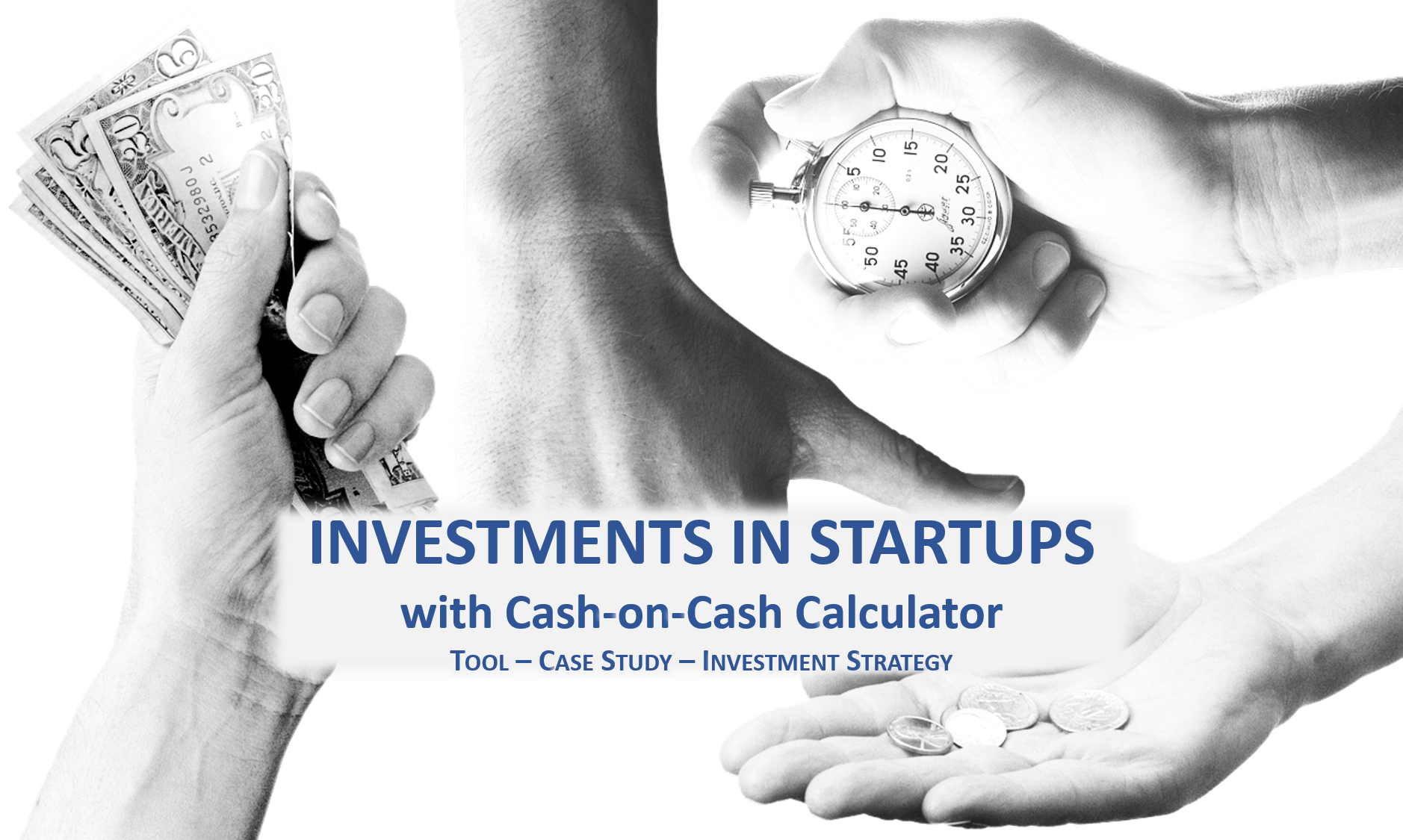How to invest in startups + Cash-on-Cash Calculator
The question of the size of the investment comes up very quickly in discussions with investors. Many founders rightly ask themselves: How many shares do I have to give my investor for his investment and why? One way to approach this question is to take the investor’s perspective: What does an investor expect from an investment in my startup?
Challenges with startup valuation
Many methods of company valuation derive the company value from the current earnings situation – e.g. the multiplier method. Others, on the other hand, evaluate future earnings expectations, but these are a direct extrapolation of the company’s history – e.g. the DCF method.
In the absence of relevant historical company figures, it is very difficult to value start-ups, as the past of start-ups is highly loss-making, while (economic) world domination is possible in the future. Thus, the multiplier method does not provide a meaningful valuation based on negative earnings. A DCF calculation also does not provide reliable results due to the planning uncertainty. Investors therefore often rely on their market experience and a heuristic approach: the cash-on-cash method.
Cash-on-cash method: expected profit on investment
The cash-on-cash valuation method is primarily based on the investor’s annual expected return. Other parameters that play a role here are the expected exit proceeds, the time until exit and the expected further dilution. These parameters are used to determine the required investment amount and the current pre- and post-money value of the startup.
How does the cash-on-cash valuation work in detail?
The cash-on-cash valuation is based on the amount of financing required. This amount X, which the startup needs, should come from the investor, who in return receives shares in the company. The investor naturally has certain return expectations for this investment, i.e. if he invests an amount now, he would like to receive a correspondingly higher amount back on exit. The investor could calculate this either with an annual interest rate or with a factor x investment.
`text{Proportion of exit proceeds by investor}= text{Investment} * (1 + text{expected return of capital by investor})^text{duration until Exit}`
Example: A business angel invests EUR 100 thousand in a start-up and has an expected annual return of 50%. After e.g. 5 years, he therefore expects 100*(100%+50%)^5 = 759 kEUR. Alternatively, one could also say that the investor would like to receive 7.6 times his investment back on exit after 5 years.
The annual return expected by investors is typically between 40% and 60%. This may seem high, but it also takes into account the high investment risk, as it is more than uncertain whether an exit will ever take place.
In the next step, the investor and the founders agree on an estimate of the exit proceeds. The required investment amount of the investor is calculated using the following formula:
` text{% of shares by investor} = frac{text{Investor’s exit proceeds}}{text{total exit proceeds}}*100%`
Example: In our example calculation, the parties involved estimate the exit proceeds after 5 years at a total of €10 million.
In the final step, the further dilution from future financing rounds must be taken into account In order to meet the investment expectations even after a further future financing round, the investor’s stake must be increased even further:
` text{% investor’s shares after dilution} = frac{text{% investor’s shares}}{100%-text{future dilution in %}}`
Example: in our example start-up, the expected future financing rounds will lead to a dilution of 20%. If we take this into account, the participation rate of our investor increases to: 9.5% = 7.6%/(100%-20%).
Example calculation for a cash-on-cash valuation
Example: amount of investor’s shares and cash-on-cash valuation
Let’s assume a business angel wants to invest EUR 400 thousand in a startup. Due to the currently still negative EBIT, a reliable valuation is not possible. Based on the knowledge of the industry dynamics and the high degree of innovation of the startup, the founder and investor share the expectation that the startup has an exit potential of € 50 million after 6 years. The investor’s annual return expectation is 50% – this high value is not unusual, as this investment is associated with a high total loss risk for the business angel. For the future, the founders expect a further financing round with a dilution of 25%.
Questions:
How many shares in the startup should the investor receive?
What is the current valuation of the startup?Expectations Business Angel Expectations Startup Investment: 0,4 Mio.€ Time till exit: 6 years Expected annual return: 50% Valuation at Exit: 50 Mio.€ Dilution in future financing rounds: 25%
In the event of an exit, the business angel expects the following exit proceeds for his investment:
`0,4 text{ Mio.€} * (100%+50%)^{6} = 4,6 text{ Mio.€}`
This results in the required investment amount – initially without further dilution from future financing rounds:
`frac{4,6 text{ Mio.€}}{50 text{ Mio.€}} = 9,1%`
However, both parties assume that there will be a further financing round in the future. Although the amount of the future financing round and the valuation are unknown, a dilution of 25% is expected. In order to secure the targeted exit proceeds for the business angel even after the further financing round, the share of the current investment must be increased to 12.2%:
`frac{9,1%}{(100%+25%} = 12,2%`
The above calculations result in a post-money valuation of €2.5 million
`frac{0,4 text{ Mio.€}}{12,2%} = 2,5 text{ Mio.€}`
And a pre-money valuation of €2.1 million
`2,5 text{ Mio.€} – 0,4 text{ Mio.€} = 2,1 text{ Mio.€}`
Conclusion: For his investment of 400 kEUR, the investor receives 12.2% of the shares in the startup. This investment amount results in a current post-money valuation of the startup in the amount of €2.5 million.
Additional strategic criteria for an investment decision
Strategic minimum investment amount
The two most common investor groups for start-ups, business angels and venture capital companies, naturally have their own ideas of a typical investment amount. This is between 5% and 15% for business angels and between 10% and 30% for VC investors. In addition to the aforementioned protection against dilution, a minimum investment level is also justified by the associated transaction costs.
Maintaining a strategic minimum participation rate for the founders is important for all parties involved, as the incentive and motivation of the founders can decrease as their participation level decreases. In addition, a sufficiently high shareholding gives the founders a weighty voice and influence in entrepreneurial decisions. This is particularly important as the founders often have a deeper understanding of the startup’s business model, vision and long-term goals. A minimum shareholding ensures that their voice in the company is (and remains) decisive and that they can play an active role in important strategic decisions. It follows that business angels and VC investors never aim for a majority stake, i.e. this group of investors is not suitable for an exit.
A strategic minimum investment is important for both sides in order to secure the long-term orientation and commitment of the founders and to create an optimal balance between the interests of all parties involved.
Preferencial rights for investments in start-ups
Preferencial rights can vary from investor to investor and from negotiation to negotiation. The most important special rights include:
Preferred shares
Investors can receive preference shares that give them advantages over the founders’ ordinary shares. These usually include preferred dividends, which are paid in priority to distributions to ordinary shareholders. In addition, preference shareholders often have the right to be paid out before holders of ordinary shares in the event of the company’s liquidation.
Participation rights
Investors may be granted a right of participation in certain important corporate decisions, e.g. the selection of the CEO, amendments to the articles of association or the approval of a new financing round. This right can take the form of a power of veto or a right of approval.
Rights to receive information
Investors often have the right to receive regular information about the startup’s business development and financial situation. This enables them to monitor the progress and performance of the company and react to potential problems at an early stage.
Rights to exit
Investors can agree exit rights that allow them to sell their shares to the company or other investors at a certain time or under certain conditions. This can give investors the flexibility to monetize their investment if they wish.
Drag-along and tag-along rights
Drag-along rights allow a particular shareholder (e.g. the lead investor) to force the other shareholders to sell their shares as part of a sale of the entire company. The tag-along right gives minority shareholders the right to join a sale or transaction initiated by a major shareholder.
Dilution protection
Investors can receive protection clauses against dilution of their shareholding. Should the company later raise additional capital at a lower valuation to attract new investors, these clauses may allow the original investors to increase their stake at a lower price in order to maintain their percentage share in the company.
The Startup CFO is happy to support you with this complex topic – you can find our services ‘as a service’ here



